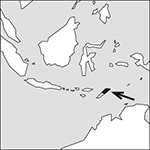
Source: MAPS IN MINUTES™ © RH Publications (1997)
Capital:
Dili
Area:
14,874 sq km (5743 sq miles)
Population:
1,172,390 (2013 est)
Currency:
1 US dollar = 100 cents
Religions:
Roman Catholic 96.9%; Protestant 2.2%; Muslim 0.3%
Ethnic Groups:
Austronesian; Papuan; Chinese minority
Languages:
Portuguese, Tetum (both official); Indonesian; English; minority languages
International Organizations:
UN; Non‐Aligned Movement
An Asian country that occupies the eastern half of the island of Timor in the southern Malay Archipelago. The western half of the island is part of Indonesia.
Physical
Timor‐Leste is mainly mountainous and has a monsoon climate.
Economy
The development of offshore oil and natural gas reserves made oil the principal export, greatly increased government revenues in the 2000s, and led to high rates of economic growth. The oil revenues financed increased government spending on electricity, roads, and other infrastructure projects. However, production peaked in 2012 and government revenue is now declining faster than expenditure, creating major economic problems (exacerbated by a border dispute with Australia over which country owns certain offshore reserves). Despite the oil boom, almost two-thirds of the workforce are employed in agriculture, two-fifths of the population live in poverty, and unemployment is high. Coffee, sandalwood, and marble are the other principal exports; other important crops include rice and maize.
History
In colonial times Timor was divided into Dutch West Timor and Portuguese East Timor. In 1950 West Timor was absorbed into the newly formed Republic of Indonesia. In 1975, during the collapse of the Portuguese colonial empire, East Timor briefly declared itself independent from Portugal but was invaded and occupied by Indonesia. In 1976, against the wishes of the inhabitants, Indonesia formally annexed East Timor and administered it as the province of Timur Timur or Loro Sae. The independence movement was violently suppressed. José Ramos-Horta, who was out of the country, became the international spokesman for the Fretilin independence movement (and shared a Nobel Peace Prize in 1996 with the Bishop of Dili, Carlos Belo). A referendum in 1999, supervised by the UN, overwhelmingly supported independence from Indonesia. However, a pro‐Indonesian militia murdered many of those who voted for independence and devastated the capital, Dili. Thousands of people fled or went into hiding. A UN administration and peacekeeping force was established to effect the transition to independence, which was achieved in May 2002 with the former guerrilla leader Xanana Gusmão as President. In 2006 there were violent protests involving former members of the security forces; UN forces were required to restore order, remaining until 2012. Ramos-Horta was elected President in 2007 and asked Gusmão to be Prime Minister; they both survived an assassination attempt in 2008; Ramos-Horta was succeeded by Taur Matan Ruak in 2012. In 2015 Gusmão resigned as Prime Minister and was replaced byRui de Araujo, the leader of Fretilin, who joined a coalition with Gusmão's Congresso Nacional da Reconstrução de Timor with the hope of increasing political stability. In the 2017 presidential elections Francisco ‘Lu-Olo’ Guterres of Fretilin was victorious.